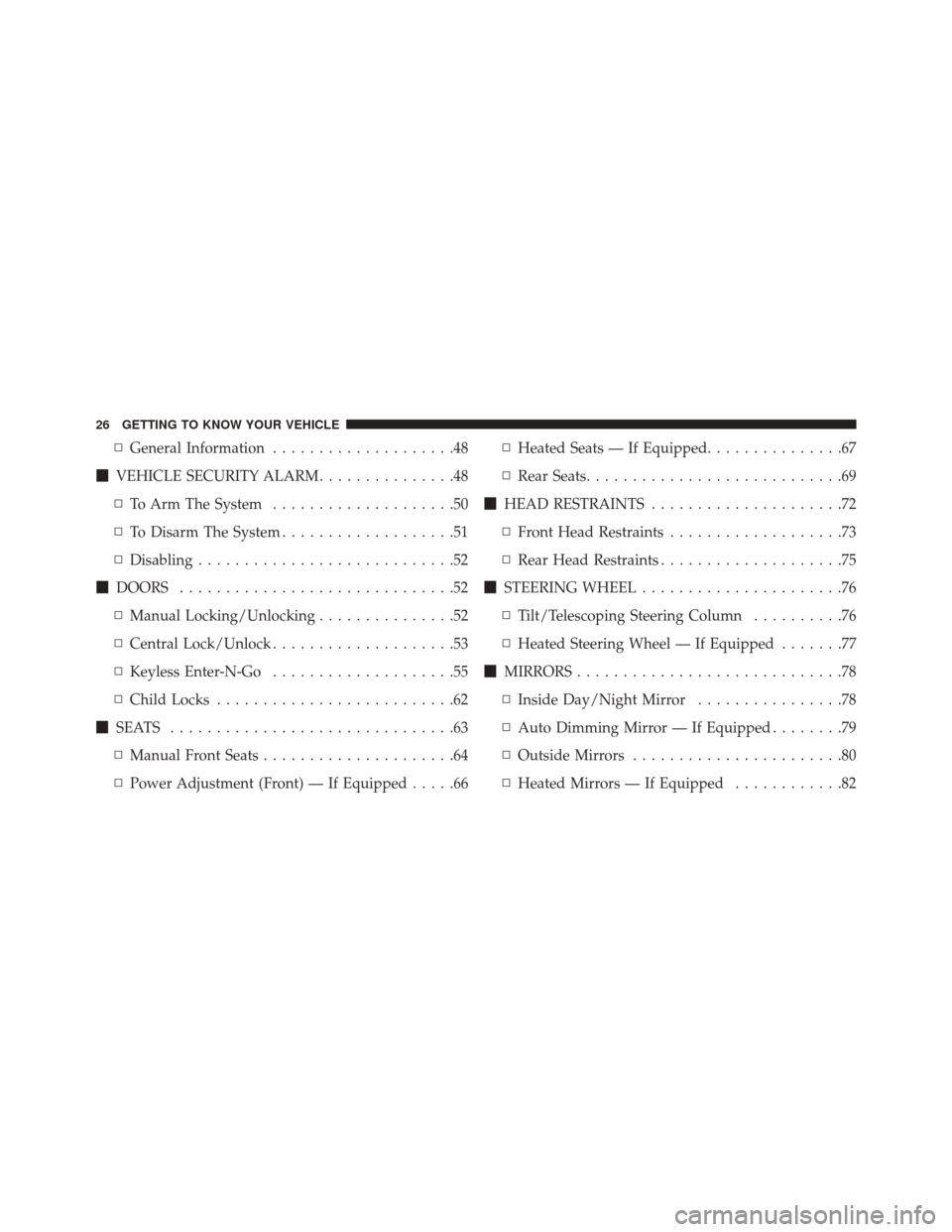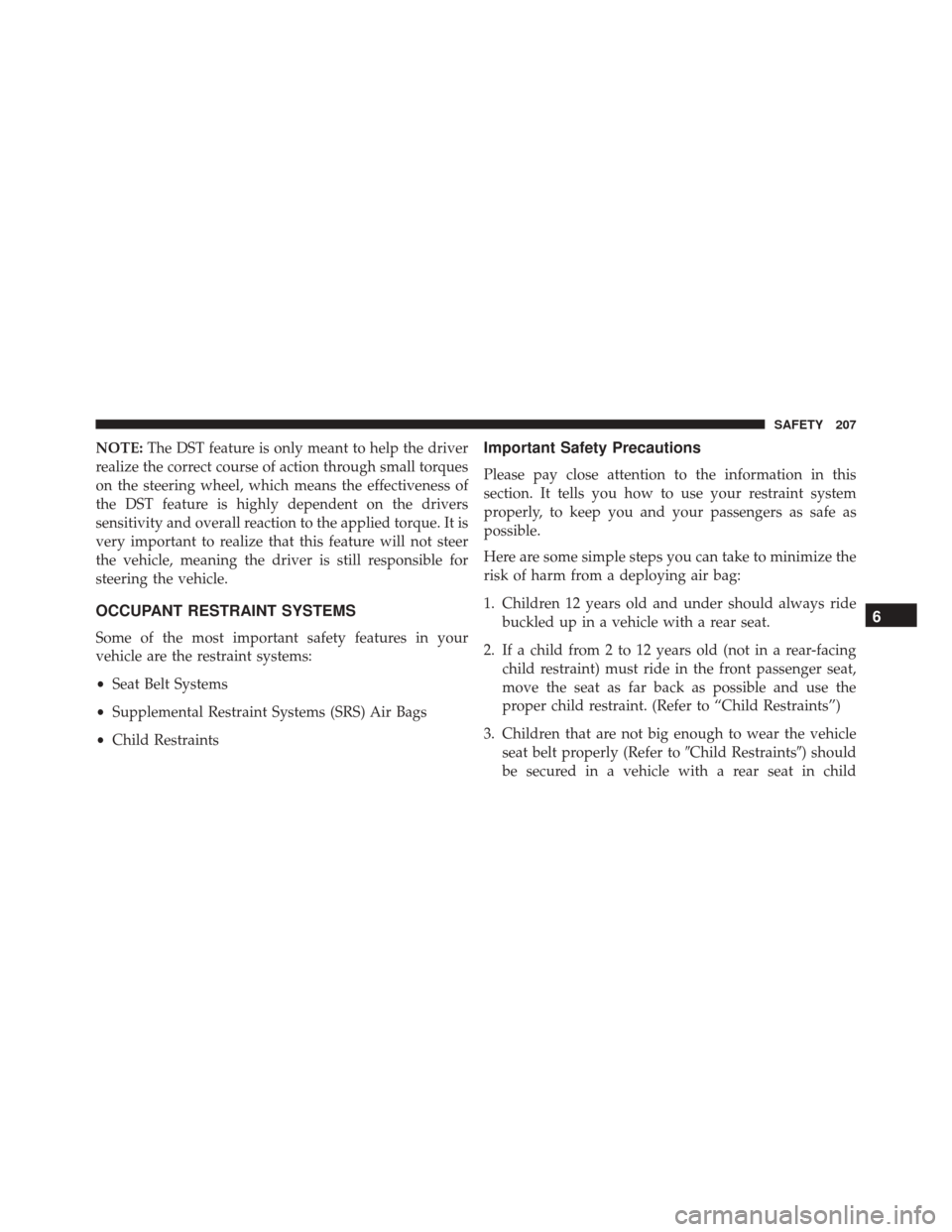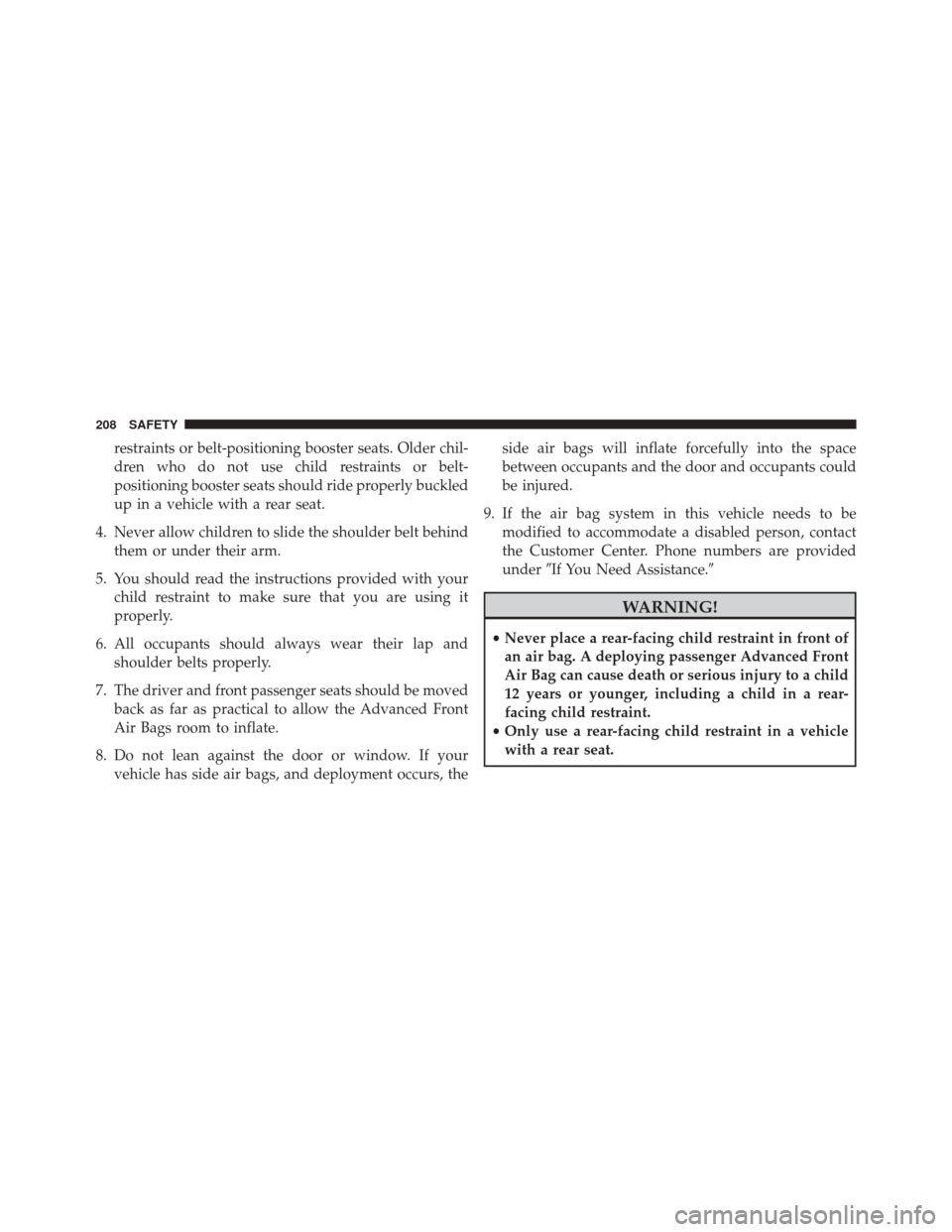Page 28 of 587

▫General Information ....................48
� VEHICLE SECURITY ALARM ...............48
▫ To Arm The System ....................50
▫ To Disarm The System ...................51
▫ Disabling ............................52
� DOORS ..............................52
▫ Manual Locking/Unlocking ...............52
▫ Central Lock/Unlock ....................53
▫ Keyless Enter-N-Go ....................55
▫ Child Locks ..........................62
� SEATS ...............................63
▫ Manual Front Seats .....................64
▫ Power Adjustment (Front) — If Equipped .....66▫
Heated Seats — If Equipped ...............67
▫ Rear Seats ............................69
� HEAD RESTRAINTS .....................72
▫ Front Head Restraints ...................73
▫ Rear Head Restraints ....................75
� STEERING WHEEL ......................76
▫ Tilt/Telescoping Steering Column ..........76
▫ Heated Steering Wheel — If Equipped .......77
� MIRRORS .............................78
▫ Inside Day/Night Mirror ................78
▫ Auto Dimming Mirror — If Equipped ........79
▫ Outside Mirrors .......................80
▫ Heated Mirrors — If Equipped ............82
26 GETTING TO KNOW YOUR VEHICLE
Page 64 of 587
Child Locks
To provide a safer environment for small children riding
in the rear seats, the rear doors are equipped with a
Child-Protection Door Lock system.
To use the system, open each rear door, use a flat blade
screwdriver (or ignition key) and rotate the dial to the
LOCK or UNLOCK position. When the system on a door
is engaged, that door can only be opened by using the
outside door handle even if the inside door lock is in the
unlocked position.
Child-Protection Door Lock Location
62 GETTING TO KNOW YOUR VEHICLE
Page 65 of 587
NOTE:
•When the child lock system is engaged, the door can
only be opened by using the outside door handle even
though the inside door lock is in the unlocked position.
• After disengaging the Child-Protection Door Lock
system, always test the door from the inside to make
certain it is in the desired position.
• After engaging the Child-Protection Door Lock sys-
tem, always test the door from the inside to make
certain it is in the desired position.
• For emergency exit with the system engaged, rotate
the lock button to the unlocked position, roll down the
window, and open the door with the outside door
handle.WARNING!
Avoid trapping anyone in a vehicle in a collision.
Remember that the rear doors can only be opened
from the outside when the Child-Protection locks are
engaged.
SEATS
Seats are a part of the Occupant Restraint System of the
vehicle.
4
GETTING TO KNOW YOUR VEHICLE 63
Page 74 of 587
2. Lift the seatbacks, pushing them back until they lockon both the latches. Verify the red notches are no
longer visible on the release lever. If the red notches
are visible, the seatback is not secure.WARNING!
Be certain that the seatback is securely locked into
position. If the seatback is not securely locked into
position the seat will not provide the proper stability
for child seats and/or passengers. An improperly
latched seat could cause serious injury.
HEAD RESTRAINTS
Head restraints are designed to reduce the risk of injury
by restricting head movement in the event of a rear
impact. Head restraints should be adjusted so that the top
of the head restraint is located above the top of your ear.
Rear Seat Latch
72 GETTING TO KNOW YOUR VEHICLE
Page 134 of 587
WARNING!
•Never leave children alone in a vehicle, or with
access to an unlocked vehicle. Never leave the Key
Fob in or near the vehicle or in a location accessible
to children. Occupants, particularly unattended
children, can become entrapped by the power sun-
roof while operating the power sunroof switch.
Such entrapment may result in serious injury or
death.
• In a collision, there is greater risk of being thrown
from a vehicle with an open sunroof. You could
also be seriously injured or killed. Always fasten
your seat belt properly and make sure all passen-
gers are properly secured too.
• Do not allow small children to operate the sunroof.
Never allow your fingers, other body parts, or any
object to project through the sunroof opening.
Injury may result.
Operation Switch
1 — Front Panel Open/Close Switch
2 — Front Panel Vent Switch 132 GETTING TO KNOW YOUR VEHICLE
Page 197 of 587
SAFETY
CONTENTS
�BRAKE SYSTEM ...................... .197
� ELECTRONIC BRAKE CONTROL SYSTEM . . . .198
▫ Electronic Brake Force Distribution (EBD) . . . .198
▫ Brake System Warning Light ..............198
▫ Anti-Lock Brake System (ABS) ............198
▫ Anti-Lock Brake Warning Light ............200
▫ Brake Assist System (BAS) ...............200
▫ Hill Start Assist (HSA) .................201
▫ Traction Control System (TCS) ............203
▫ Electronic Stability Control (ESC) ..........204▫
Electronic Roll Mitigation (ERM) ..........205
▫ Dynamic Steering Torque (DST) ...........206
� OCCUPANT RESTRAINT SYSTEMS .........207
▫ Important Safety Precautions .............207
▫ Seat Belt Systems .....................209
▫ Supplemental Restraint System (SRS) .......224
▫ Child Restraints ..................... .241
▫ Transporting Pets .....................262
� SAFETY TIPS ........................ .262
▫ Transporting Passengers .................262
6
Page 209 of 587

NOTE:The DST feature is only meant to help the driver
realize the correct course of action through small torques
on the steering wheel, which means the effectiveness of
the DST feature is highly dependent on the drivers
sensitivity and overall reaction to the applied torque. It is
very important to realize that this feature will not steer
the vehicle, meaning the driver is still responsible for
steering the vehicle.
OCCUPANT RESTRAINT SYSTEMS
Some of the most important safety features in your
vehicle are the restraint systems:
• Seat Belt Systems
• Supplemental Restraint Systems (SRS) Air Bags
• Child Restraints
Important Safety Precautions
Please pay close attention to the information in this
section. It tells you how to use your restraint system
properly, to keep you and your passengers as safe as
possible.
Here are some simple steps you can take to minimize the
risk of harm from a deploying air bag:
1. Children 12 years old and under should always ride
buckled up in a vehicle with a rear seat.
2. If a child from 2 to 12 years old (not in a rear-facing child restraint) must ride in the front passenger seat,
move the seat as far back as possible and use the
proper child restraint. (Refer to “Child Restraints”)
3. Children that are not big enough to wear the vehicle seat belt properly (Refer to �Child Restraints�) should
be secured in a vehicle with a rear seat in child
6
SAFETY 207
Page 210 of 587

restraints or belt-positioning booster seats. Older chil-
dren who do not use child restraints or belt-
positioning booster seats should ride properly buckled
up in a vehicle with a rear seat.
4. Never allow children to slide the shoulder belt behind them or under their arm.
5. You should read the instructions provided with your child restraint to make sure that you are using it
properly.
6. All occupants should always wear their lap and shoulder belts properly.
7. The driver and front passenger seats should be moved back as far as practical to allow the Advanced Front
Air Bags room to inflate.
8. Do not lean against the door or window. If your vehicle has side air bags, and deployment occurs, the side air bags will inflate forcefully into the space
between occupants and the door and occupants could
be injured.
9. If the air bag system in this vehicle needs to be modified to accommodate a disabled person, contact
the Customer Center. Phone numbers are provided
under �If You Need Assistance.�
WARNING!
•Never place a rear-facing child restraint in front of
an air bag. A deploying passenger Advanced Front
Air Bag can cause death or serious injury to a child
12 years or younger, including a child in a rear-
facing child restraint.
• Only use a rear-facing child restraint in a vehicle
with a rear seat.
208 SAFETY